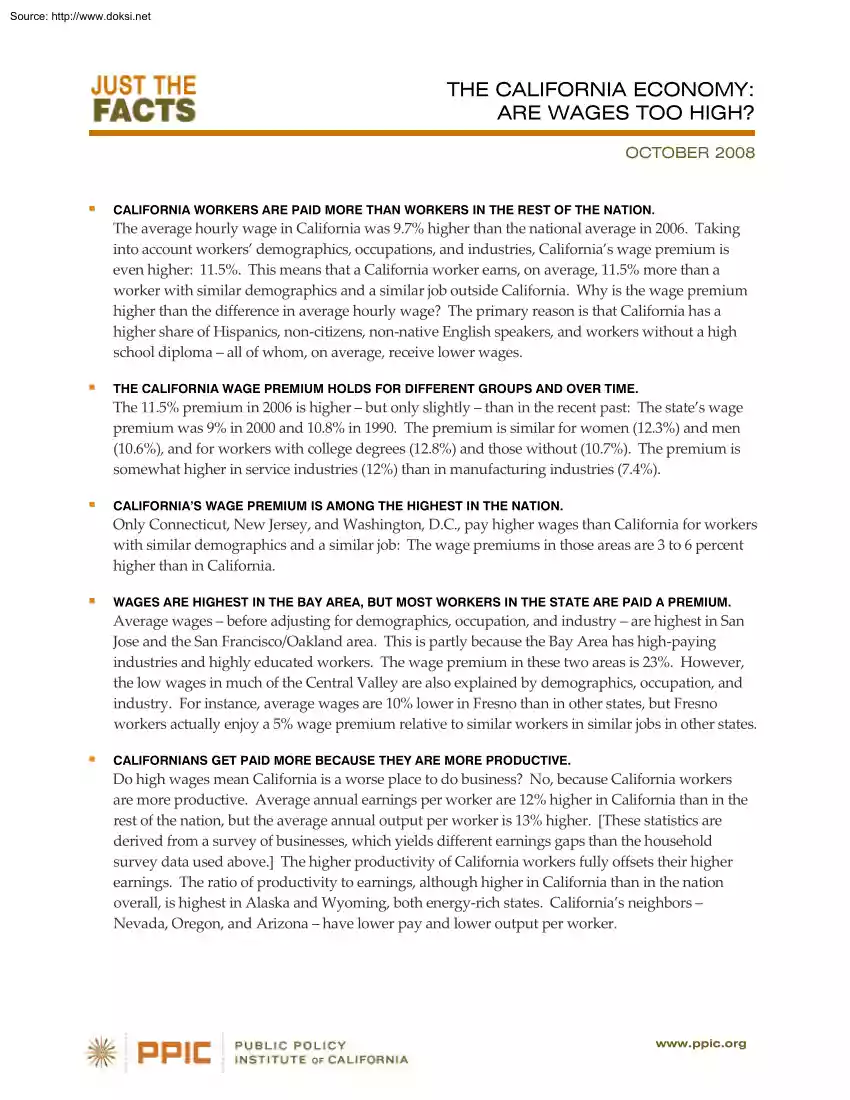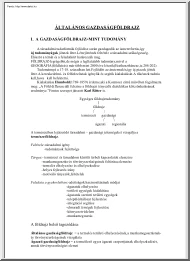Datasheet
Year, pagecount:2008, 2 page(s)
Language:English
Downloads:3
Uploaded:April 29, 2019
Size:560 KB
Institution:
-
Comments:
Attachment:-
Download in PDF:Please log in!
Comments
No comments yet. You can be the first!Most popular documents in this category
Content extract
Source: http://www.doksinet THE CALIFORNIA ECONOMY: ARE WAGES TOO HIGH? OCTOBER 2008 CALIFORNIA WORKERS ARE PAID MORE THAN WORKERS IN THE REST OF THE NATION. The average hourly wage in California was 9.7% higher than the national average in 2006 Taking into account workers’ demographics, occupations, and industries, California’s wage premium is even higher: 11.5% This means that a California worker earns, on average, 115% more than a worker with similar demographics and a similar job outside California. Why is the wage premium higher than the difference in average hourly wage? The primary reason is that California has a higher share of Hispanics, non‐citizens, non‐native English speakers, and workers without a high school diploma – all of whom, on average, receive lower wages. THE CALIFORNIA WAGE PREMIUM HOLDS FOR DIFFERENT GROUPS AND OVER TIME. The 11.5% premium in 2006 is higher – but only slightly – than in the recent past: The state’s wage premium was
9% in 2000 and 10.8% in 1990 The premium is similar for women (123%) and men (10.6%), and for workers with college degrees (128%) and those without (107%) The premium is somewhat higher in service industries (12%) than in manufacturing industries (7.4%) CALIFORNIA’S WAGE PREMIUM IS AMONG THE HIGHEST IN THE NATION. Only Connecticut, New Jersey, and Washington, D.C, pay higher wages than California for workers with similar demographics and a similar job: The wage premiums in those areas are 3 to 6 percent higher than in California. WAGES ARE HIGHEST IN THE BAY AREA, BUT MOST WORKERS IN THE STATE ARE PAID A PREMIUM. Average wages – before adjusting for demographics, occupation, and industry – are highest in San Jose and the San Francisco/Oakland area. This is partly because the Bay Area has high‐paying industries and highly educated workers. The wage premium in these two areas is 23% However, the low wages in much of the Central Valley are also explained by
demographics, occupation, and industry. For instance, average wages are 10% lower in Fresno than in other states, but Fresno workers actually enjoy a 5% wage premium relative to similar workers in similar jobs in other states. CALIFORNIANS GET PAID MORE BECAUSE THEY ARE MORE PRODUCTIVE. Do high wages mean California is a worse place to do business? No, because California workers are more productive. Average annual earnings per worker are 12% higher in California than in the rest of the nation, but the average annual output per worker is 13% higher. [These statistics are derived from a survey of businesses, which yields different earnings gaps than the household survey data used above.] The higher productivity of California workers fully offsets their higher earnings. The ratio of productivity to earnings, although higher in California than in the nation overall, is highest in Alaska and Wyoming, both energy‐rich states. California’s neighbors – Nevada, Oregon, and Arizona
– have lower pay and lower output per worker. www.ppicorg Source: http://www.doksinet Average Wage and Wage Premium, Relative to Rest of U.S San Jose San Francisco - Oakland Ventura San Diego Sacramento Santa Rosa Stockton Los Angeles - Long Beach Riverside - San Bernardino Santa Barbara Modesto Average wage Bakersfield Wage premium Fresno Visalia - Tulare -30 -20 -10 0 10 20 30 40 50 % Salary and Output Per Worker, Selected States, Relative to U.S New York California Texas Alaska Arizona Nevada Florida Annual salary per worker Oregon Annual output per worker Wyoming -30 -20 -10 0 10 20 30 40 50 % Note: Calculations of wage premium controlled for education, experience, race and ethnicity, gender, marital status, number of children, full-time vs. part-time employment, citizenship, language, metropolitan area location, detailed occupation, and detailed industry Sources: U.S Census Bureau Bureau of Labor Statistics Bureau of Economic Analysis Contact: Jed
Kolko www.ppicorg
9% in 2000 and 10.8% in 1990 The premium is similar for women (123%) and men (10.6%), and for workers with college degrees (128%) and those without (107%) The premium is somewhat higher in service industries (12%) than in manufacturing industries (7.4%) CALIFORNIA’S WAGE PREMIUM IS AMONG THE HIGHEST IN THE NATION. Only Connecticut, New Jersey, and Washington, D.C, pay higher wages than California for workers with similar demographics and a similar job: The wage premiums in those areas are 3 to 6 percent higher than in California. WAGES ARE HIGHEST IN THE BAY AREA, BUT MOST WORKERS IN THE STATE ARE PAID A PREMIUM. Average wages – before adjusting for demographics, occupation, and industry – are highest in San Jose and the San Francisco/Oakland area. This is partly because the Bay Area has high‐paying industries and highly educated workers. The wage premium in these two areas is 23% However, the low wages in much of the Central Valley are also explained by
demographics, occupation, and industry. For instance, average wages are 10% lower in Fresno than in other states, but Fresno workers actually enjoy a 5% wage premium relative to similar workers in similar jobs in other states. CALIFORNIANS GET PAID MORE BECAUSE THEY ARE MORE PRODUCTIVE. Do high wages mean California is a worse place to do business? No, because California workers are more productive. Average annual earnings per worker are 12% higher in California than in the rest of the nation, but the average annual output per worker is 13% higher. [These statistics are derived from a survey of businesses, which yields different earnings gaps than the household survey data used above.] The higher productivity of California workers fully offsets their higher earnings. The ratio of productivity to earnings, although higher in California than in the nation overall, is highest in Alaska and Wyoming, both energy‐rich states. California’s neighbors – Nevada, Oregon, and Arizona
– have lower pay and lower output per worker. www.ppicorg Source: http://www.doksinet Average Wage and Wage Premium, Relative to Rest of U.S San Jose San Francisco - Oakland Ventura San Diego Sacramento Santa Rosa Stockton Los Angeles - Long Beach Riverside - San Bernardino Santa Barbara Modesto Average wage Bakersfield Wage premium Fresno Visalia - Tulare -30 -20 -10 0 10 20 30 40 50 % Salary and Output Per Worker, Selected States, Relative to U.S New York California Texas Alaska Arizona Nevada Florida Annual salary per worker Oregon Annual output per worker Wyoming -30 -20 -10 0 10 20 30 40 50 % Note: Calculations of wage premium controlled for education, experience, race and ethnicity, gender, marital status, number of children, full-time vs. part-time employment, citizenship, language, metropolitan area location, detailed occupation, and detailed industry Sources: U.S Census Bureau Bureau of Labor Statistics Bureau of Economic Analysis Contact: Jed
Kolko www.ppicorg





